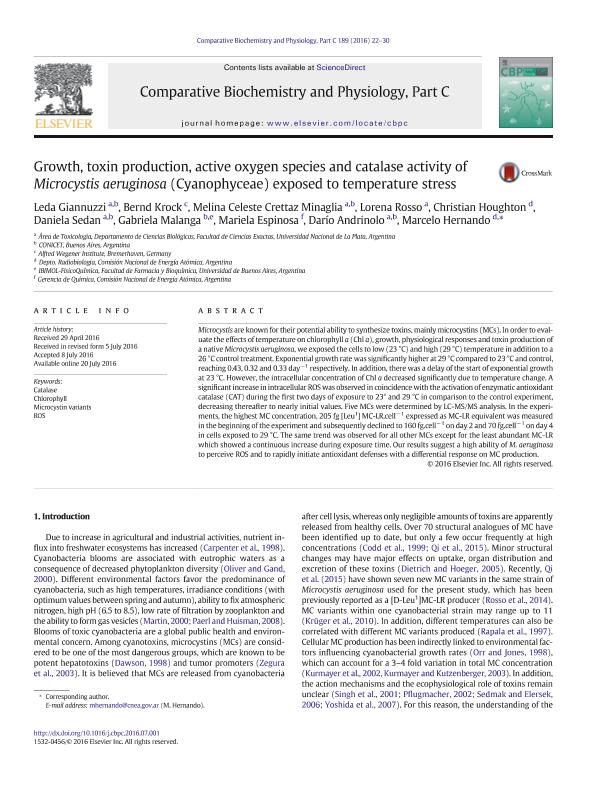Mostrar el registro sencillo del ítem
dc.contributor.author
Giannuzzi, Leda

dc.contributor.author
Krock, Bernd
dc.contributor.author
Crettaz Minaglia, Melina Celeste

dc.contributor.author
Rosso, Lorena Vanesa

dc.contributor.author
Houghton, Christian
dc.contributor.author
Sedan, Daniela Yazmine

dc.contributor.author
Malanga, Gabriela Fabiana

dc.contributor.author
Espinosa, Mariela
dc.contributor.author
Andrinolo, Dario

dc.contributor.author
Hernando, Marcelo Pablo

dc.date.available
2018-06-06T13:44:53Z
dc.date.issued
2016-11
dc.identifier.citation
Giannuzzi, Leda; Krock, Bernd; Crettaz Minaglia, Melina Celeste; Rosso, Lorena Vanesa; Houghton, Christian; et al.; Growth, toxin production, active oxygen species and catalase activity of Microcystis aeruginosa (Cyanophyceae) exposed to temperature stress; Elsevier Science Inc; Comparative Biochemistry And Physiology. Toxicology & Pharmacology; 189; 11-2016; 22-30
dc.identifier.issn
1532-0456
dc.identifier.uri
http://hdl.handle.net/11336/47439
dc.description.abstract
Microcystis are known for their potential ability to synthesize toxins, mainly microcystins (MCs). In order to evaluate the effects of temperature on chlorophyll a (Chl a), growth, physiological responses and toxin production of a native Microcystis aeruginosa, we exposed the cells to low (23 °C) and high (29 °C) temperature in addition to a 26 °C control treatment. Exponential growth rate was significantly higher at 29 °C compared to 23 °C and control, reaching 0.43, 0.32 and 0.33 day−1 respectively. In addition, there was a delay of the start of exponential growth at 23 °C. However, the intracellular concentration of Chl a decreased significantly due to temperature change. A significant increase in intracellular ROS was observed in coincidence with the activation of enzymatic antioxidant catalase (CAT) during the first two days of exposure to 23° and 29 °C in comparison to the control experiment, decreasing thereafter to nearly initial values. Five MCs were determined by LC-MS/MS analysis. In the experiments, the highest MC concentration, 205 fg [Leu1] MC-LR.cell− 1 expressed as MC-LR equivalent was measured in the beginning of the experiment and subsequently declined to 160 fg.cell− 1 on day 2 and 70 fg.cell− 1 on day 4 in cells exposed to 29 °C. The same trend was observed for all other MCs except for the least abundant MC-LR which showed a continuous increase during exposure time. Our results suggest a high ability of M. aeruginosa to perceive ROS and to rapidly initiate antioxidant defenses with a differential response on MC production.
dc.format
application/pdf
dc.language.iso
eng
dc.publisher
Elsevier Science Inc

dc.rights
info:eu-repo/semantics/openAccess
dc.rights.uri
https://creativecommons.org/licenses/by-nc-sa/2.5/ar/
dc.subject
Catalase
dc.subject
Chlorophyll
dc.subject
Microcystin Variants
dc.subject
Ros
dc.subject
Catalase
dc.subject
Chlorophyll
dc.subject
Ros
dc.subject.classification
Toxicología

dc.subject.classification
Medicina Básica

dc.subject.classification
CIENCIAS MÉDICAS Y DE LA SALUD

dc.title
Growth, toxin production, active oxygen species and catalase activity of Microcystis aeruginosa (Cyanophyceae) exposed to temperature stress
dc.type
info:eu-repo/semantics/article
dc.type
info:ar-repo/semantics/artículo
dc.type
info:eu-repo/semantics/publishedVersion
dc.date.updated
2018-06-05T20:05:36Z
dc.journal.volume
189
dc.journal.pagination
22-30
dc.journal.pais
Estados Unidos

dc.journal.ciudad
Amsterdam
dc.description.fil
Fil: Giannuzzi, Leda. Consejo Nacional de Investigaciones Científicas y Técnicas; Argentina. Universidad Nacional de La Plata. Facultad de Ciencias Exactas. Departamento de Ciencias Biológicas. Área de Toxicología; Argentina
dc.description.fil
Fil: Krock, Bernd. Alfred Wegener Institute; Alemania
dc.description.fil
Fil: Crettaz Minaglia, Melina Celeste. Consejo Nacional de Investigaciones Científicas y Técnicas; Argentina. Universidad Nacional de La Plata. Facultad de Ciencias Exactas. Departamento de Ciencias Biológicas. Área de Toxicología; Argentina
dc.description.fil
Fil: Rosso, Lorena Vanesa. Universidad Nacional de La Plata. Facultad de Ciencias Exactas. Departamento de Ciencias Biológicas. Área de Toxicología; Argentina
dc.description.fil
Fil: Houghton, Christian. Comisión Nacional de Energía Atómica; Argentina
dc.description.fil
Fil: Sedan, Daniela Yazmine. Consejo Nacional de Investigaciones Científicas y Técnicas; Argentina. Universidad Nacional de La Plata. Facultad de Ciencias Exactas. Departamento de Ciencias Biológicas. Área de Toxicología; Argentina
dc.description.fil
Fil: Malanga, Gabriela Fabiana. Consejo Nacional de Investigaciones Científicas y Técnicas. Oficina de Coordinación Administrativa Houssay. Instituto de Bioquímica y Medicina Molecular. Universidad de Buenos Aires. Facultad Medicina. Instituto de Bioquímica y Medicina Molecular; Argentina
dc.description.fil
Fil: Espinosa, Mariela. Comisión Nacional de Energía Atómica; Argentina
dc.description.fil
Fil: Andrinolo, Dario. Consejo Nacional de Investigaciones Científicas y Técnicas; Argentina. Universidad Nacional de La Plata. Facultad de Ciencias Exactas. Departamento de Ciencias Biológicas. Área de Toxicología; Argentina
dc.description.fil
Fil: Hernando, Marcelo Pablo. Comisión Nacional de Energía Atómica; Argentina
dc.journal.title
Comparative Biochemistry And Physiology. Toxicology & Pharmacology

dc.relation.alternativeid
info:eu-repo/semantics/altIdentifier/doi/https://dx.doi.org/10.1016/j.cbpc.2016.07.001
dc.relation.alternativeid
info:eu-repo/semantics/altIdentifier/url/https://www.sciencedirect.com/science/article/pii/S1532045616300734
Archivos asociados
